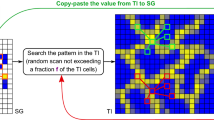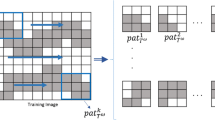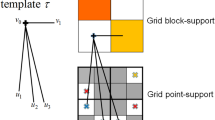Abstract
Some multiple-point-based sampling algorithms, such as the snesim algorithm, rely on sequential simulation. The conditional probability distributions that are used for the simulation are based on statistics of multiple-point data events obtained from a training image. During the simulation, data events with zero probability in the training image statistics may occur. This is handled by pruning the set of conditioning data until an event with non-zero probability is found. The resulting probability distribution sampled by such algorithms is a pruned mixture model. The pruning strategy leads to a probability distribution that lacks some of the information provided by the multiple-point statistics from the training image, which reduces the reproducibility of the training image patterns in the outcome realizations. When pruned mixture models are used as prior models for inverse problems, local re-simulations are performed to obtain perturbed realizations. Consequently, these local re-simulations lead to additional pruning in the set of conditioning data, which further deteriorates the pattern reproduction. To mitigate this problem, it is here suggested to combine the pruned mixture model with a frequency matching model. The multiple-point statistics of outcome realizations from this combined model has improved degree of match with the statistics from the training image. An efficient algorithm that samples this combined model is suggested. Finally, a tomographic cross-borehole inverse problem with prior information expressed by the combined (prior) model is used to demonstrate the effect of pattern reproducibility on the resolution of an inverse problem.









Similar content being viewed by others
References
Alabert F (1987) The practice of fast conditional simulations through LU decomposition of the covariance matrix. Math Geol 19(5):369–386
Binley A, Winship P, Middleton R, Pokar M, West J (2001) High resolution characterization of vadose zone dynamics using cross-borehole radar. Water Resour Res 37:2639–2652
Bishop CM (2006) Pattern recognition and machine learning. Springer, New York
Boucher A, Kyriakidis PC, Cronkite-Ratcliff C (2008) Geostatistical solutions for super-resolution land cover mapping. IEEE Trans Geosci Remote Sens 46(1):272–283
Caers J, Hoffman T (2006) The probability perturbation method: a new look at Bayesian inverse modeling. Math Geol 38(1):81–100
Castillo E, Gutiérrez JM, Hadi AS (1997) Expert systems and probabilistic network models. Springer-Verlag New York, Inc, New York
Cordua KS, Looms MC, Nielsen L (2008) Accounting for correlated data errors during inversion of cross-borehole ground penetrating radar data. Vadose Zone J 7(1):263–271
Cordua KS, Nielsen L, Looms MC, Hansen TM, Binley A (2009) Quantifying the influence of static-like errors in least-squares-based inversion and sequential simulation of cross-borehole ground penetrating radar data. J Appl Geophys 68:71–84
Cordua KS, Hansen TM, Mosegaard K (2012) Monte Carlo full-waveform inversion of crosshole GPR data using multiple-point geostatistical a priori information. Geophysics 77:H19–H31
Cressie N, Davidson J (1998) Image analysis with partially order Markov models. Comput Stat Data Anal 29:1–26
Daly C (2005) Higher order models using entropy, Markov random fields and sequential simulation. In: Leuangthong O, Deutsch CV (eds) Quantitative geology and geostatistics, geostatistics Banff 2004, part 1. Springer Netherlands, pp 215–224
Deutsch CV, Journel AG (1998) GSLIB: Geostatistical software library. Oxford University Press, Oxford
Emery X, Lantuéjoul C (2013) Can a training image be a substitute for a random field model? Geosci Math. doi:10.1007/s11004-013-9492-z
Faucher C, Saucier A, Marcotte D (2013) A new patchwork simulation method with control of the local-mean histogram. Stoch Environ Res Risk Assess 27:253–273
Geman S, Geman D (1984) Stochastic relaxation, Gibbs distributions, and the Bayesian restoration of images. IEEE Trans Pattern Anal Mach Intell 6:721–741
Geyer CJ, Thompson EA (1995) Annealing Markov chain Monte Carlo with applications to ancestral inference. J Am Stat Assoc 90:909–920
Gómez-Hernández J, Cassiraga EF (2000) Sequential conditional simulations with linear Constrains. In: Monestiez P, Allard D, Froideveaux R (eds) Geostatistics’2000 Cape Town. Geostatistical Association of Southern Africa, Cape Town
Guardiano FB, Srivastava RM (1993) Multivariate geostatistics: beyond bivariate moments. In: Soares A (ed) Geostatistics-Troia, vol 1. Kluwer Academic Publishers, Dordrecht, p 133–144
Hansen TM, Mosegaard K, Cordua KS (2008) Using geostatistics to describe complex a priori information for inverse problems. In: Ortiz JM, Emery X (eds) GEOSTATS 2008, Proceedings of the Eighth International Geostatistics Congress, Chile, vol 1. p 329–338
Hansen TM, Mosegaard K, Cordua KS (2009) Reducing complexity of inverse problems using geostatistical priors. IAMG 2009, Stanford, CA
Hansen TM, Cordua KS, Mosegaard K (2012) Inverse problems with non-trivial priors: efficient solution through sequential Gibbs sampling. Comput Geosci 16:593–611
Hansen TM, Cordua KS, Looms MC, Mosegaard K (2013) SIPPI: A Matlab toolbox for sampling the solution to inverse problems with complex prior information Part 2–application to crosshole GPR tomography. Comput Geosci 52:481–492
Hastings WK (1970) Monte Carlo sampling methods using Markov chains and their applications. Biometrika 57:97–109
Irving J, Singha K (2010) Stochastic inversion of tracer test and electrical geophysical data to estimate hydraulic conductivities. Water Resour Res 46:W11514
Jensen CS, Kjærulff U (1995) Blocking Gibbs sampling in very large probabilistic expert systems. Int J Hum Comput Stud 42:647–666
Journel AG (1974) Geostatistics for conditional simulation of ore bodies. Econ Geol 69:673–687
Journel A, Zhang T (2006) The necessity of a multiple-point prior model. Math Geol 38:591–610
Kjønsberg H, Stien M, Kolbjørnsen O, Fjellvoll B, Abrahamsen P (2012) Using multiple grids in Markov mesh facies modeling. In: Ninth international geostatistics congress, Oslo, Norway, 11–15 June
Lange K, Frydendall J, Cordua KS, Hansen TM, Melnikova Y, Mosegaard K (2012) A frequency matching method: solving inverse problems by use of geologically realistic prior information. Math Geosci 44:783–803
Mariethoz G, Kelly BFJ (2011) Modeling complex geological structures with elementary training images and transform-invariant distances. Water Resour Res 47:W07527
Mariethoz G, Renard P, Caers J (2010a) Bayesian inverse problem and optimization with iterative spatial resampling. Water Resour Res 46:W11530
Mariethoz G, Renard P, Straubhaar (2010b) The Direct Sampling method to perform multiple-point geostatistical simulations. Water Resour Res 46:W11536
McCullagh P, Nelder J (1989) Generalized linear models, 2nd edn. Chapman and Hall, Boca Raton
Metropolis N, Rosenbluth AW, Rosenbluth MN, Teller AH, Teller E (1953) Equation of state calculations by fast computing machines. J Chem Phys 1(6):1087–1092
Mosegaard K (2006) Monte Carlo analysis of inverse problems. Doctoral Thesis, Faculty of Science, University of Copenhagen
Mosegaard K, Tarantola A (1995) Monte Carlo sampling of solutions to inverse problems. J Geophys Res 100(B7):431–447
Newell GF, Montroll EW (1953) On the theory of the Ising model of ferromagnetism. Rev Mod Phys 25:353–389
Stien M, Kolbjørnsen O (2011) Facies modeling using a Markov mesh model specification. Math Geosci 43:611–624
Strebelle S (2002) Conditional simulation of complex geological structures using multiple-point statistics. Math Geol 34:1–21
Strebelle S, Zhang T (2004) Non-stationary multiple-point geostatistical models. In: Leuangthong O, Deutsch CV (eds) Geostatistics Banff 2004. Springer, New York, pp 235–244
Tarantola A (2005) Inverse problem theory and methods for model parameter estimation. Society of Industrial and Applies Mathematics, Philadelphia
Tarantola A, Valette B (1982) Inverse problems = quest for information. J Geophys 50:159–170
Tjelmeland H (1996) Stochastic models in reservoir characterization and Markov random fields for compact objects. PhD thesis, Norwegian University of Science and Technology. Thesis Number 44:1996
Tjelmeland H, Besag J (1998) Markov random fields with higher order interactions. Scand J Stat 25:415–433
Toftaker H, Tjelmeland H (2013) Construction of binary multi-grid Markov random field prior models from training images. Math Geosci 45:383–409
Tuanfeng Z, Stein IP, McCormick D (2008) Patched path and recursive servo system in multi-point geostatistical simulation. In: Proceeding of Geostats 2008. Santiago, Chile
Zelt C, Barton P (1998) Three-dimensional seismic refraction seismic refraction tomography—a comparison of two methods applied to data from the Faeroe Basin. J Geophys Res 103(B4):7187–7210
Acknowledgments
We thank DONG E&P for financial support. Moreover, we are very grateful for the comments and suggestions that were provided by associated editor Odd Kolbjørnsen and two anonymous reviewers, which we believe improved this paper considerably.
Author information
Authors and Affiliations
Corresponding author
Rights and permissions
About this article
Cite this article
Cordua, K.S., Hansen, T.M. & Mosegaard, K. Improving the Pattern Reproducibility of Multiple-Point-Based Prior Models Using Frequency Matching. Math Geosci 47, 317–343 (2015). https://doi.org/10.1007/s11004-014-9531-4
Received:
Accepted:
Published:
Issue Date:
DOI: https://doi.org/10.1007/s11004-014-9531-4




